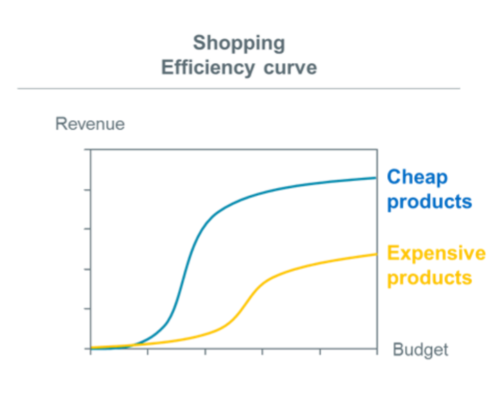Think you’re too small to benefit from Google Shopping campaigns? Think again! Columnist Andreas Reiffen has some advice for smaller retailers looking to improve their Product Listing Ads.
To a small niche retailer, it can seem daunting (almost pointless) to invest too heavily in Google Shopping. After all, how could you ever compete with the major players who have far more money, products and people than you do?
Well, the good news is, it is possible to be competitive in Google Shopping as a small business. In fact, done right, Google Shopping can actually be the most effective digital advertising platform in terms of Return on Ad Spend (ROAS).
Here are the top strategies for success as a small to medium-sized retailer in Google Shopping.
1. Focus on your niche
As a small retailer, you likely sell a very limited selection of niche products. Whether these are your own personal brand or from independent designers, this exclusivity is your strength.
Selling products that aren’t sold by Amazon or a hundred other retailers means there’s less competition to appear in Google Shopping for relevant searches. Even better, if you create and sell your own label, you won’t have any direct competition in terms of brand queries. Private labels have the added benefit of commanding higher margins, making them a smart investment for any business.
Focus your campaigns on niche, new or unknown brands, and try to get these products exclusively.
2. Segment your campaigns effectively
The key to creating Google Shopping ads with great ROAS is making sure they reach the people who are most likely to buy. In the example below, you can see that query A is much more specific — and therefore more likely to convert — than query B, yet the bid is the same. Your strategy should be to leave the generic traffic to your competitors and get more of the high-converting traffic to your business.
 100vw, 722px” data-lazy-src=”https://searchengineland.com/wp-content/seloads/2017/02/Feb-SEL-1-722×600.png” /></p>
<p>To generate the maximum amount of sales from Google Shopping, you want to make sure your ads appear for these types of “high-conversion” queries. As with any form of paid media, that generally means bidding slightly more.</p>
<p>But <a href=) reverse engineering of Google Shopping has revealed that simply bidding higher on your PLAs makes your ads attract more low-quality traffic. Instead, you want to focus on displaying your ads for specific queries, which tend to convert much better. This is why segmenting your campaigns correctly is essential.
reverse engineering of Google Shopping has revealed that simply bidding higher on your PLAs makes your ads attract more low-quality traffic. Instead, you want to focus on displaying your ads for specific queries, which tend to convert much better. This is why segmenting your campaigns correctly is essential.
By segmenting your campaigns into the type of queries that receive high, medium and low conversion rates (this will likely differ from business to business) you can set bid amounts that correlate to the user’s intent. That way, you bid more for “high-converting” queries and less for “low-converting” queries.
 100vw, 800px” data-lazy-src=”https://searchengineland.com/wp-content/seloads/2017/02/Feb-SEL-2-800×298.png” /></p>
<p>Here’s a more detailed description of <a href=) how campaign segmentation works.
how campaign segmentation works.
3. Use natural language in product titles
As a retailer selling new or small, unknown brands, it’s unlikely that you will get a high volume of search traffic looking for that brand specifically. Instead, you want to focus your attention on popular natural language queries that describe your products.
You can use Google’s Keyword Planner to identify the queries that most closely match your product offerings — remember to focus on products that are unique to you. Once you’ve identified these queries, append them to the beginning of the relevant Product Titles in your Product Feed.
 100vw, 800px” data-lazy-src=”https://searchengineland.com/wp-content/seloads/2017/02/F-800×353.png” /></p>
<p>This method will help Google be better at finding and surfacing your products when they match the query. It will also make your products look more relevant to shoppers. In many cases, updating your product titles with natural language queries can double, if not triple, your impressions without the need to increase your bids, making it a cost-effective way for smaller retailers to compete.</p>
<p>Here’s a handy guide for <a href=) writing more compelling product titles.
writing more compelling product titles.
4. Use geotargeting
Another way to make sure your ads are reaching those shoppers most likely to purchase your products is through geotargeting. Obviously, you first want to make sure you are only advertising your products to people in the areas where you deliver.
But, you can also use geotargeting in a more granular way by bidding higher for your ads to show in very specific areas. For example, if you are a high-end fashion retailer, you may want to bid more for ads shown in high-income areas where the people searching are more likely to be able to afford your products.
Use something like this buying power map to help determine where your ads would have the most impact and invest heavily in those areas.
, RLSA (remarketing lists for search ads), or <a href=) retargeting lists, can be extremely useful.
retargeting lists, can be extremely useful.
These lists allow you to bid more for ads that will be shown to people who have already visited your site — and therefore are more likely to purchase your products. You can even make these lists more specific by targeting customers who have purchased before, or just those with an Average Basket Value above a certain amount.
6. Don’t bid too much
No one ever wants to bid more than they have to. But it’s especially important to remember, when working with limited budgets, that simply increasing your CPC is not the answer to getting more sales in Google Shopping.
Bidding in Google Shopping works very differently from traditional PPC bidding. Instead of decreasing marginal revenue, there is an S curve.
 100vw, 565px” data-lazy-src=”https://searchengineland.com/wp-content/seloads/2017/02/Feb-SEL-3-565×600.png” /></p>
<p>Essentially, in Google Shopping, there is a minimum bid amount to be entered into the auction, then for small bid increases, we see a huge jump in conversions. But at a certain point, the bid becomes too high, and the conversion rate plateaus. When the bid is too high, it means Google is showing your products for very generic queries that are unlikely to convert.</p>
<p>If you’re not paying attention, it’s easy to overbid on your Google Shopping campaigns. Setting and forgetting your bids is simply not an option. Instead, you need a system of incremental testing, measuring and tweaking. Make small changes in your bids and see what happens to your conversion rate. If it goes up by a lot, try increasing the bid a bit more until you see a very small (or no) change in conversion rate. If you don’t have the time to manually test all of your bids, you should invest in a tool that can automate that process for you.</p>
<p>When in doubt, it’s much better to be highly targeted with your bids — through RLSA lists, geotargeting, campaign segmentation and so on — than to try to “outbid” any major players through raising your base CPC.</p>
<h2>7. Decrease your prices</h2>
<p>If you do sell some of the same products or brands as your competitors, you’ll often get more out of Google Shopping by decreasing your prices than by just increasing your bids. This may sound somewhat counterintuitive, but it has to do with Google’s algorithm for selecting which products to show.</p>
<p>In an effort to make Google Shopping more appealing to online shoppers, Google seems to have what we call a “<a href=) low-price bias.” That means that given the choice between two products, Google will almost always choose to show the cheaper of the two, even if the more expensive product has a higher bid. In fact, if your products are too expensive, Google may refuse to show them at all.
low-price bias.” That means that given the choice between two products, Google will almost always choose to show the cheaper of the two, even if the more expensive product has a higher bid. In fact, if your products are too expensive, Google may refuse to show them at all.

According to Google, their algorithm doesn’t favor cheaper products. Rather, they apply a machine learning algorithm which reacts to what users like or dislike. In this case, users apparently dislike high prices, and therefore, the algorithm chooses lower-priced products. Either way, the bottom line is the same: price matters.
In order to compete against bigger online retailers, you may want to consider lowering your prices — at least on the items that you sell in common. In reality, once you get people to your site, they’ll often end up buying something other than what they initially clicked on. Think of these lower-priced products as “gateways” to your site. Once a shopper is on your site, you can try to upsell them to a different or an additional product. You can also add them to your retargeting lists for future promotion.
If lowering any of your prices isn’t an option, try focusing your campaigns on the items you sell that are more competitive in price for their category. Over time, you’ll gather data on which products perform best in Google Shopping and can start to focus your energies into those products.
Invest smarter, then grow
You don’t necessarily have to invest a ton upfront to make Google Shopping successful for your business. Take time to refine your strategy, and make sure you know (or find out through testing) the answers to these questions:
- Which products make you stand out from the competition?
- What types of shopper queries indicate high conversion potential?
- Which words/phrases do people search for that could describe your products?
- Where do your customers (real and potential) live, and what other areas have similar demographics?
- How long is your conversion cycle? What is the optimum time frame to wait before retargeting someone?
- What bid range is most efficient for your products?
- How competitive are your prices?
Once you’ve created highly efficient Google Shopping campaigns, you can begin to ramp up your spending and aim for a larger market share.
The most important thing to remember as a small to medium-sized retailer is to focus on what makes you unique. This uniqueness is why someone would choose to purchase from you in the first place, and it’s also what will make your ads stand out to both Google and online shoppers.




